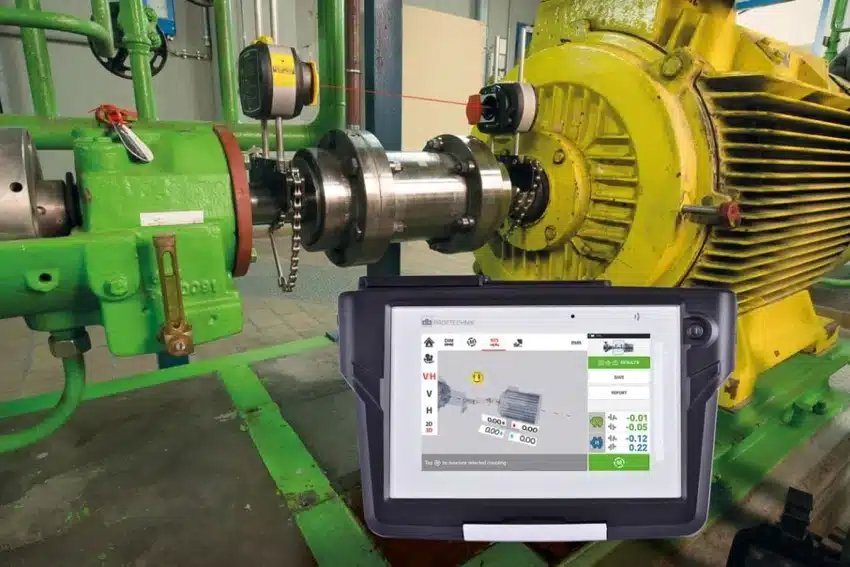Proper motor alignment can keep your rotating machinery up and running for longer, drastically reducing breakdowns and increasing overall productivity.

An estimated 50% of breakdowns in rotating machinery are caused by faulty alignment. Even when misalignment doesn’t cause breakdowns, it can cause other issues that impact your whole operation. Misalignment tends to result in higher energy costs, premature wear and tear on seals and bearings, and broken parts.
Fortunately, these are all preventable issues. With the right tools, you can keep tabs on machine alignment and easily correct misalignment issues before they lead to failure. This is a great way to extend the lifecycle of your assets and increase uptime throughout your plant.
Why is Motor-Pump Alignment Important?
Motor-driven pumps are powerhouses; they’re among the most commonly used tools in industries from construction to oil and gas. Since these tools are so crucial to most operations, proper motor-pump alignment is very important.
Normally, your motor and pump are connected by two shafts. Check for correct alignment at the point of power transfer between the motor shaft and the pump shaft. When the shafts are properly aligned, their axes of rotation should be collinear, lying in a straight line.
Technicians can use precision instruments, like laser shaft alignment tools, to make sure that these two shafts are perfectly aligned. Even small degrees of misalignment can lead to excess vibration and rattling, noise, and a range of related problems.
What Happens When Motors and Pumps are Misaligned?
Misaligned pumps usually require more energy to keep running. Their parts experience greater wear and tear, which means more frequent maintenance and higher cost. Bearing, seals, and shafts all wear down more quickly when your motors and pumps are misaligned.
Misalignment also causes machinery to overheat and to emit greater vibration. Higher temperatures and vibration levels damage assets and causes fatigue on machine parts. Overall, faulty alignment means that you’ll see higher failure rates and greater inefficiency. Your equipment will also behave more erratically, and you’ll have more slowdowns as well as sudden emergencies.
This makes planning a challenge. It also makes it much more difficult to implement a proactive maintenance approach. Fortunately, correct alignment is easy to achieve. There are reliable and effective tools available that are affordable on almost any budget. These days, achieving proper alignment is even without highly trained staff thanks to alignment tools that can be used by almost any skill level.
Motor Alignment Best Practices
Your team should check the alignment of all your motor-driven assets on a regular basis. The first check should be done during the installation process. However, monitoring and fixing alignment issues is an ongoing process.
Equipment manufacturers will do a preliminary check to ensure that the asset is properly aligned. But it’s important to test any new equipment during the installation process, especially since positioning can affect alignment. It’s also possible that temperature changes will impact your new equipment and have a knock-on effect on alignment. Again, once your asset is correctly installed, your technicians should continue to perform regular alignment checks.
When checking for alignment, your technicians will carefully measure the distance and angles between the motor and the pump shaft. Minor misalignments are almost impossible to spot using the naked eye alone. In fact, even some of the tools traditionally used to measure alignment can fail to catch every instance of misalignment.
It’s worth noting that, if your employees don’t have a solid technical background, they may not be able to spot misalignment using some of the older approaches. It’s important to make sure that you choose the right tools for the job. Here are some of the devices used to measure alignment:
The “eyesight” or “eyeball” method relies on eyesight, experience, and a few simple tools. At its most basic, technicians might gauge alignment using just a straightedge and their own vision.
A slightly more advanced “eyeball” method incorporates a feeler gauge or a set of calipers to measure the exact distance between two coupling halves. The technician then rotates the shafts and measures the distance once again, repeating this process for the horizontal alignment measures. This generally requires a trained and skilled technician to visibly identify issues with accuracy and precision.
Dial Indicators can also be used to measure the position of both shafts. By carefully measuring position as the shafts are moved, technicians can ensure that they bring the shafts into correct alignment.
Dial indicators have the potential to be highly accurate. However, they require a highly trained technician with a solid understanding of mathematics and the time to spend carefully measuring. In many modern plants, especially those with many assets, this is simply not possible.
Today, many operations are choosing laser alignment tools because they offer greater accuracy combined with speed and ease of use for most skill levels.
Benefits of a Laser Shaft Alignment Tool
Laser alignment tools are highly accurate and precise. They are also intuitive to use, even for employees who don’t have a technical background.
To use a laser shaft alignment tool, simply mount your laser sensor onto one shaft, and attach the laser emitter to the other. The laser emitter sends a laser beam to the sensor to check whether the two shafts have a common rotation line.
There’s no need to manually measure or calculate. The laser alignment tool makes the calculations for you and sends the information to an intuitive dashboard that visually guides you through the process of alignment. The best laser alignment tools use color coding to show the degree of alignment and includes simple directions for fixing the alignment. Your technicians simply keep making adjustments and checking the display until the parts are perfectly aligned.
Conclusion
Fixing shaft alignment issues is one of the best ways to extend the life of your equipment. It’s important to equip your plant with the right tools to get that job done. Laser alignment tools make it easy. They remove the hassle and stress associated with checking shaft alignment.


